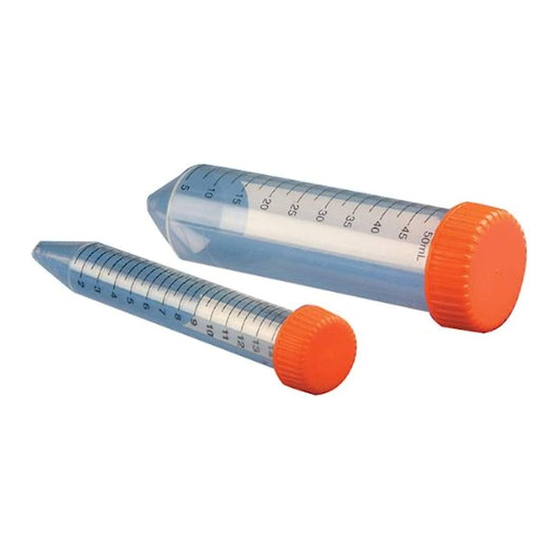CORNING 431485 Datos técnicos e instrucciones de uso - Página 2
Navegue en línea o descargue pdf Datos técnicos e instrucciones de uso para Equipos de laboratorio CORNING 431485. CORNING 431485 5 páginas. Uf 6 and 20 ml concentrators

Introduction
Corning
®
Spin-X
®
UF concentrators are disposable, single use only ultrafiltration
devices with polyethersulfone membranes (PES) for the concentration and/or
purification of biological samples. Spin-X UF 6 concentrators are suitable for sample
volumes of 2 to 6 mL and the Spin-X UF 20 concentrators can handle samples up to
20 mL. Both products feature twin vertical membranes for unparalleled speed.
The innovative design, ease of use, speed and exceptional concentrate recoveries are the
main features of the concentrators.
Storage Conditions and Shelf Life
Spin-X UF concentrators should be stored at room temperature. The devices should
be used before the expiration date printed on the box.
Chemical Compatibility
Spin-X UF concentrators are designed for use with biological fluids and aqueous
solutions. For chemical compatibility details, refer to Table 4 (page 6).
Centrifugal Operation
Spin-X UF concentrators can be used in swing bucket or fixed angle rotors accepting
standard conical bottom tubes. In a single spin, solutions can be concentrated in
excess of 100-fold. Samples are typically concentrated in 10 to 30 minutes with
macromolecular recoveries in excess of 95%.
The longitudinal membrane orientation and thin channel concentration chamber provide
optimum cross flow conditions even for particle laden solutions; the centrifugal force
pulling particles and solids away from the membrane to the bottom of the device.
Macromolecules collect in an impermeable concentrate pocket integrally molded
below the membrane surface, thereby eliminating the risk of filtration to dryness.
Required Equipment
1. Centrifuge with swing bucket or fixed angle rotor (minimum 25°).
Device
Carrier Required
Spin-X UF 6
To fit 15 mL (17 mm diameter) conical bottom tubes
Spin-X UF 20
To fit 50 mL (30 mm diameter) conical bottom tubes
2. Pasteur or standard pipets for sample addition. Pipettors with gel loading tips are
recommended for sample removal from the concentrate pocket.
Rotor Compatibility
lease note: Spin-X UF 20 (30 mm x 116 mm) is designed to fit into rotors that can
accommodate Corning 50 mL conical bottom tubes, e.g., Beckman Allegra 25R with
TS-5.1-500 swing-out rotor with BUC 5 buckets and 368327 adaptors; Beckman
TA-10.250 25° fixed angle rotor with 356966 adaptors; Heraeus Multifuge 3 S-R with
(Heraeus/Sorvall) 75006445 swing out rotor with 75006441 buckets and adaptors for
Corning 50 mL conical bottom tubes.
2
These devices are not designed to fit into rotors that only accept round bottom
5
29 mm x 10
mm tubes, e.g., Sorvall SS34 or Beckman JA 20.
Operation
1. Select the most appropriate membrane cut-off for your sample. For maximum
recovery select a molecular weight cut off (MWCO) at least 50% smaller than the
molecular size of the species of interest.
2. Fill concentrator with up to maximum volumes shown in Table 1 (page 4). Ensure
screw closure is fully seated.
3. Insert assembled concentrator into centrifuge (when fixed angle rotors are used,
angle concentrator so that the printed window faces upwards/outwards).
4. Centrifuge at speeds recommended in Table 2 (page 5), taking care not to exceed the
maximum g force indicated by membrane type and MWCO.
5. Once the desired concentration is achieved, (see Tables 3a and 3b, page 5) for guide
to concentration times), remove assembly and recover sample from the bottom of
the concentrate pocket with a pipet.
Desalting/Buffer Exchange
1. Concentrate sample to desired level.
2. Empty filtrate container.
3. Refill concentrator with an appropriate solvent.
4. Concentrate the sample again and repeat the process
until the concentration of the contaminating micro-
solute is sufficiently reduced. Typically, 3 wash cycles
will remove 99% of initial salt content.
Removing the Spin-X® UF Body from the Filtrate Tube
The sleeve (seen from the end) is oval in cross section
(Figure 1). The tube is round in cross section to give
a tight fit to the sleeve. To release the tube from the
sleeve, you must pinch the tube — to press it into an
oval shape — before removing it with a twisting action.
Helpful Hints
1. Flow Rate
Filtration rate is affected by several parameters, includ-
ing MWCO, porosity, sample concentration, viscosity,
centrifugal force and temperature. Expect significantly
longer spin times for starting solutions with over 5%
solids. When operating at 4°C, flow rates are approxi-
mately 1.5 times slower than at 25°C. Viscous solutions
such as 50% glycerin will take up to 5 times longer to con-
centrate than samples in a predominantly buffer solution.
Figure 1.
3
